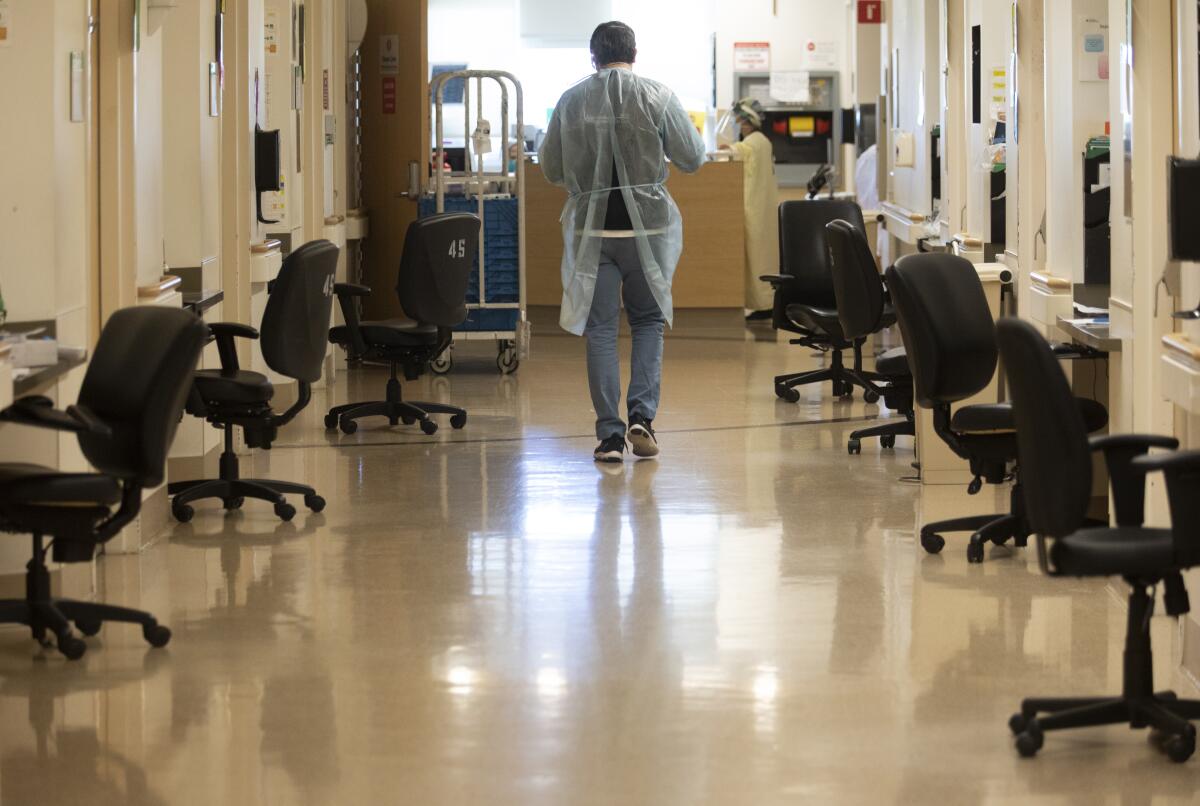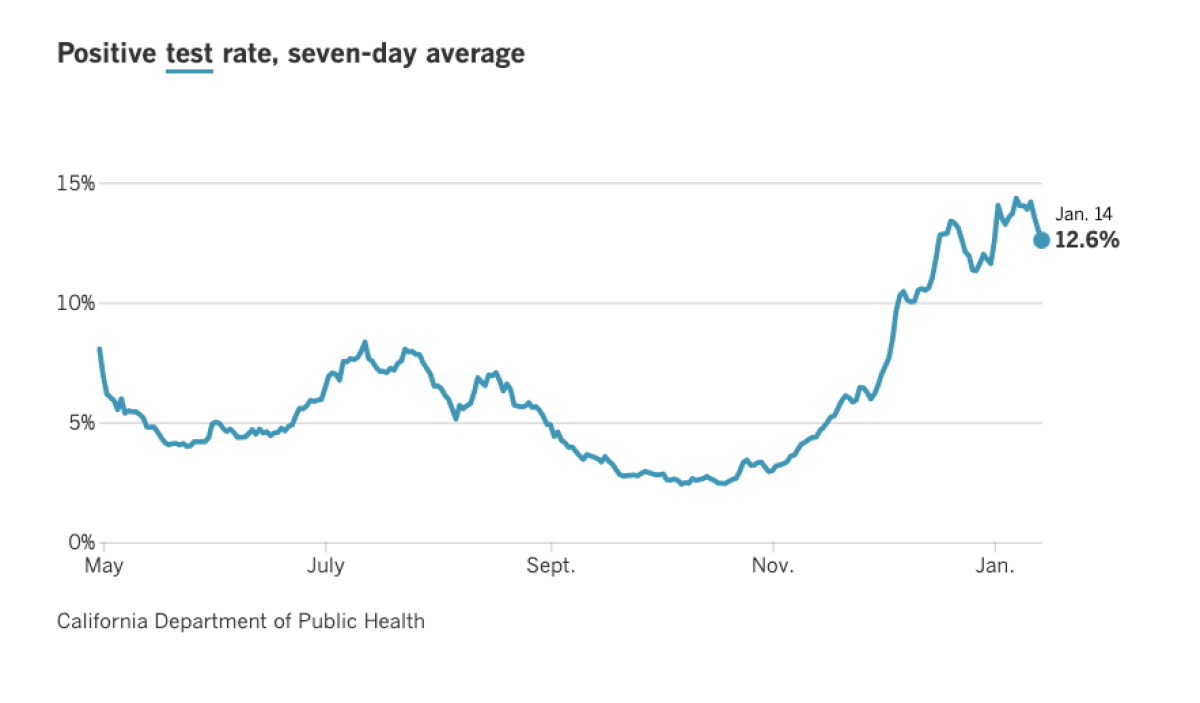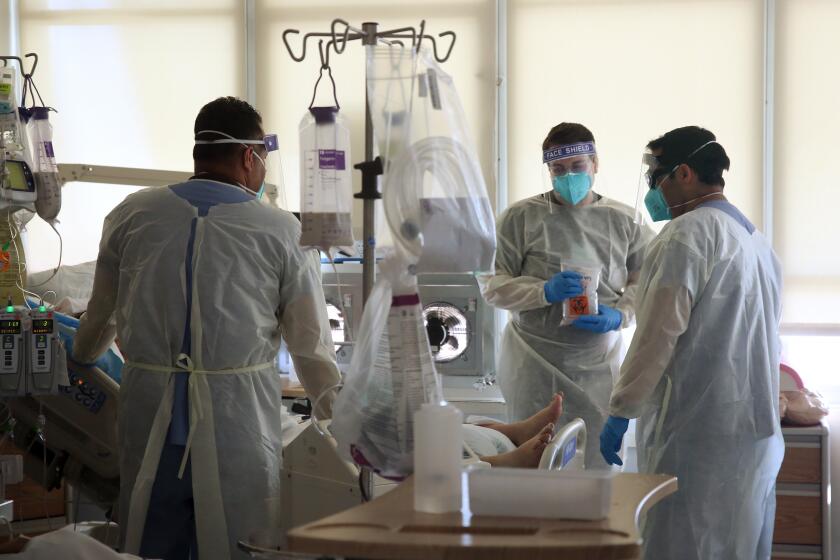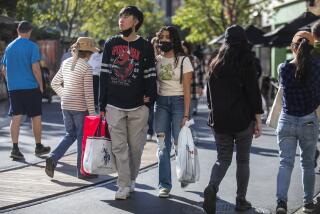‚ÄėLight at the end of tunnel‚Äô or a small blip? Flattening COVID-19 numbers bring hope in California

Despite hospitals overflowing with patients, heartbreaking numbers of deaths and COVID-19 infection rates hovering at dangerous levels, there are some signs that the daily increase in the number of coronavirus cases is beginning to flatten in California.
It may take a few more days or weeks to be assured of the trend ‚ÄĒ and the flattening could be reversed if people ease up further on mask wearing and social distancing. But a number of state and local officials are voicing cautious optimism that the unrestrained, exponential daily worsening of the pandemic has slowed.
Gov. Gavin Newsom described the flattening numbers as ‚Äúlight at the end of the tunnel,‚ÄĚ adding that the coronavirus test positivity rate and the number of people in hospitals and intensive care units with COVID-19 have been declining.
‚ÄúWe‚Äôve seen some encouraging signs,‚ÄĚ Newsom said. ‚ÄúBut now, more than ever, it‚Äôs incumbent upon us not to let our guard down, not to let our masks off and to make sure that we‚Äôre doing everything in our power to maintain that discipline purposefulness to work our way through yet another surge.‚ÄĚ

Even in hard-hit Los Angeles County, there were glimmers Friday that the crisis might no longer be worsening, at least for now. But conditions in hospitals are so dire that officials say there is little to celebrate, and there remains concern that things could worsen quickly.
‚ÄúIt‚Äôs hard to know what to make of a bump up one day [and] a slightly lower number another day,‚ÄĚ said Dr. Paul Simon, chief science officer for the Los Angeles County Department of Public Health. ‚ÄúI‚Äôm hopeful that we‚Äôre plateauing. We‚Äôre plateauing at a very, very high level, unfortunately. ‚Ķ This is much too high a level of community spread.‚ÄĚ
In L.A. County, the average daily number of coronavirus cases over a weekly period climbed to one of its highest numbers in the pandemic ‚ÄĒ to 15,102 for the seven-day period that ended Wednesday. But by Friday night, the county was averaging about 14,600 cases a day over a weekly period. On Friday, a Times tally found 14,557 cases reported in L.A. County.
California hit one of its worst average daily numbers of new coronavirus cases on Sunday ‚ÄĒ nearly 45,000 cases a day, the second-highest figure of the pandemic. But since then, the number has stopped increasing, and is floating between 41,000 and 44,000 cases a day.
The last time California recorded a record number of COVID-19 hospitalized patients was on Jan. 6, topping out at 21,936. The last record number for greatest number of COVID-19 ICU patients was on Sunday, with 4,868 in the ICU.
By Thursday, there were 20,998 people with COVID-19 in California’s hospitals, including 4,745 in the ICU.
Dr. Mark Ghaly, the state health and human services secretary, said in an interview this week that the recent relative improvements in the pandemic trends are a sign that the regional stay-at-home orders that began being put in place about six weeks ago are working.
Nothing is assured there still won‚Äôt be a significant surge in the weeks ahead, but there is a bit more optimism that the recent surge was ‚Äúblunted ... compared to what we were bracing for,‚ÄĚ Ghaly said.
But it could be only a momentary bright spot as officials express concern about a more contagious variant of the coronavirus, first identified in Britain in September, which is expected to circulate more widely in California and could quickly become the dominant variety by March.
Preliminary studies suggest it’s about 50% more transmissible than the conventional variety, and if more people get infected, hospitalizations will worsen and more people will die. It has already been identified in San Diego and San Bernardino counties.
‚ÄúWe‚Äôre quite concerned about this variant because we‚Äôve seen what‚Äôs happened in England, where it went from being a relatively infrequent source of infection in the early fall to ... being the predominant strain in southeast England,‚ÄĚ Simon said.
L.A. County races to vaccinate as many people as possible against the coronavirus before a strain thought to be even more contagious takes hold.
L.A. County officials did not disclose Friday additional information on whether they would issue new orders aimed at stymieing the spread of the disease. Settings that could be scrutinized further include outdoor gyms, which have been allowed to open at 50% capacity, and indoor malls and retail, which are supposed to be open at only 20% capacity, Mayor Eric Garcetti said Thursday night.
Simon acknowledged that the public is exhausted with battling the pandemic. And ‚Äúwe‚Äôve seen over the last several months less adherence to our restrictions. ‚Ķ We can implement additional restrictions, but unless they‚Äôre adhered to, they‚Äôre not going to have the desired impact.‚ÄĚ
‚ÄúI think our greatest hope, to be honest, is to roll out this vaccine as quickly as possible. We‚Äôre working hard to do that and to continue to implore folks to adhere as much as possible to our restrictions,‚ÄĚ he said.
Even if people can‚Äôt adhere to all of the restrictions all the time, Simon said, he urged people to adhere to them as much as possible. For instance, the official L.A. County guidance is a ban on gatherings among people outside of your household. But he also said going for a walk outside with a few friends who have also been staying at home ‚ÄĒ while everyone is wearing masks and keeping physically distant from one another ‚ÄĒ is probably a safe activity.
‚ÄúWe just don‚Äôt want you to congregate into large groups,‚ÄĚ he said. ‚ÄúWe do recognize the pain of social isolation that has just been overwhelming. ‚Ķ We‚Äôre just urging people to hang in there. We‚Äôre, I think, moving in a favorable path with the vaccine.‚ÄĚ
The fact that the vaccines have been reported to be 95% effective, Simon said, ‚Äúis almost like a miracle.‚ÄĚ
California‚Äôs daily death toll remains extraordinarily high. On Friday, the state reported a record number of COVID-19 deaths in a single day ‚ÄĒ 700, according to a tally of health jurisdictions conducted by The Times, breaking the record of 685 tallied on Jan. 8.
California is now averaging 536 reported deaths a day over the past week, a record, and roughly equivalent to one death every three minutes. Nearly 33,000 Californians with COVID-19 have died in this pandemic.
L.A. County reported 260 deaths on Friday. The county is averaging 233 deaths a day over the last week, one of the highest such figures of the pandemic.
Hospitals across Southern California are continuing to struggle with horrifying overcrowding. In Los Angeles County, hospital morgues are so full that 16 members of the California National Guard have been called in to help store corpses as funeral homes and mortuaries work through a backlog. As of Tuesday, the L.A. County coroner was holding about 150 bodies among people who have died of COVID-19.
Riverside County has also procured additional storage space to store bodies ‚ÄĒ 10 refrigerated trailers, eight of which can store 50 bodies per trailer.
There are complicated reasons for delays. Sometimes, families are taking longer to make decisions ‚Äúbecause they‚Äôre hopeful that they might be able to wait a little bit, and maybe be able to gather, bring family in,‚ÄĚ said Shane Reichardt, spokesman for the Riverside County Emergency Management Department. ‚ÄúThere‚Äôs some financial concerns. ‚Ķ People are struggling financially for a number of reasons, many of them COVID related.‚ÄĚ
There were so many people with COVID-19 in Riverside County’s 17 hospitals that 133% of the county’s licensed ICU beds were occupied earlier this week. That means hospitals have been forced to convert hospital beds not normally used for critically ill patients and rejigger them to accommodate ICU patients.
‚ÄúSome of the hospitals are doing things like converting conference rooms ‚Ķ into patient areas,‚ÄĚ Reichardt said.
Efforts are underway to convert a 65-bed outpatient surgery center at Riverside University Health System Medical Center, the county’s public hospital, to expand ICU and high-acuity medical surge capacity. And at Riverside Community Hospital, there are efforts to repurpose an area set aside for future expansion of the emergency department to accommodate critically ill patients.
Hospitals in Orange County were so busy this week that Fountain Valley Regional Hospital and Medical Center activated its 25-bed mobile field hospital supplied by the county. Another has been set up at Los Alamitos Medical Center, but hasn’t yet been used, said Jennifer Bayer, a spokeswoman for Tenet Healthcare, which runs both hospitals, as well as Lakewood Regional Medical Center and Placentia-Linda Hospital.
But in just the last few days, hospital officials have noticed a slight steadying of hospitalizations. ‚ÄúIt‚Äôs not climbing. It‚Äôs holding,‚ÄĚ Bayer said. ‚ÄúWe hope it‚Äôs a leveling off ‚ÄĒ I think it‚Äôs too early to say. It‚Äôs really just been the last couple of days.‚ÄĚ
Times staff writer Iris Lee contributed to this report.
More to Read
Sign up for Essential California
The most important California stories and recommendations in your inbox every morning.
You may occasionally receive promotional content from the Los Angeles Times.














